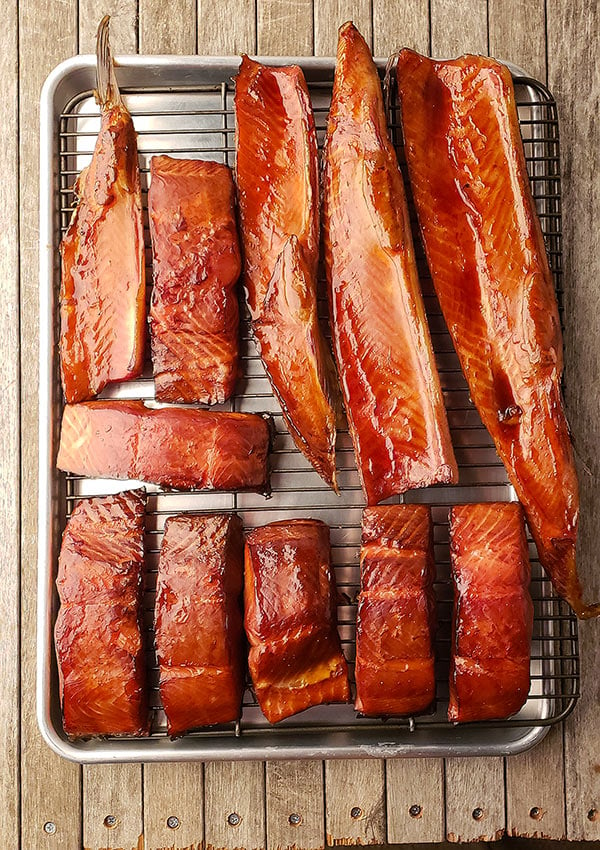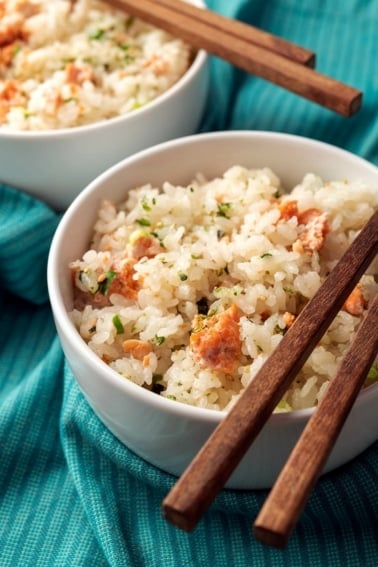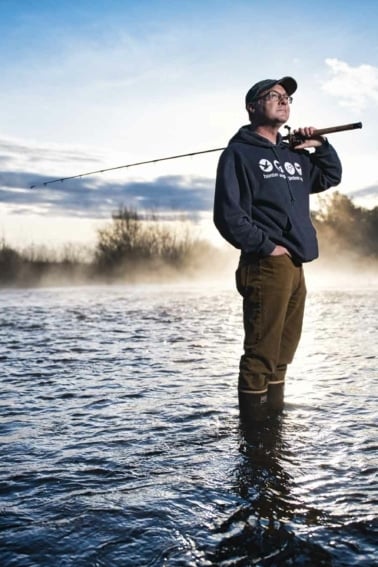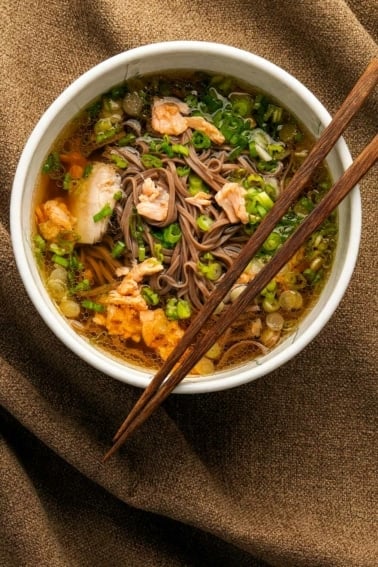As an Amazon Associate I earn from qualifying purchases.

I smoke a lot of salmon, and I am proud of this recipe, although it would be the height of arrogance to say that what I do is the end-all, be-all of salmon smoking recipes. Lots of people smoke their salmon in lots of ways, and many of them are good. But I’ve been smoking fish for many years, and I’ve developed a system that works well.
Keep in mind this is a hot-smoking recipe. Cold smoking, which is the kind of slice-able smoked fish you get in fancy boxes from Scotland is an entirely different thing.
Almost everyone in Salmon Country hot smokes their fish. If you’re unfamiliar with hot-smoked fish, think about those golden smoked whitefish you see in delicatessens; those are hot smoked.
How do you eat it? Well, you can just eat it plain, or you can flake it and make it into a smoked salmon salad, you can pound it with butter and make salmon rillettes, serve it in deviled eggs, tossed with pasta… you get the point.
Here’s what you need to get started:
- A smoker. I’ve uses a Traeger and a Bradley. Both are good. No matter what smoker you use, you will need to be able to a) know your smoking chamber’s temperature, and b) control the heat, at least in a rough sense.
- Wood. The only downside to a Traeger smoker is that you need to use their wood pellets. As a guy who used a Brinkmann wood-fired BBQ for years, fueling it with scraps of almond and other fruit woods, buying wood can be annoying, but you get better precision with this method. I prefer to use alder wood for my salmon, but apple, cherry, oak or maple work fine.
- Salt. Buy a box of kosher salt from the supermarket. Do not use regular table salt, as it contains iodide and anti-caking agents that will give your salmon an “off” flavor. I use Diamond Crystal, which is cut finer than Morton’s.
- Something sweet — salmon love sweet. I prefer to sweeten my smoked salmon with birch syrup; It’s just like maple syrup, only tapped from birch trees instead. Super cool stuff. But maple syrup is just as good. Just use real maple syrup, OK? Not the imitation crap. Honey works, too.
- A large plastic container. Buy the big, flat ones from the supermarket. They stack easily in a normal fridge, so you can have two different brines going. And they clean easily and are pretty cheap.
- A wire rack. You need to rest your brined fish on a rack with plenty of air circulation to form the all-important pellicle (more on that in a bit), and you will use it to rest the smoked fish before storing it.
- A basting brush. You probably already have this in your kitchen, but if not, pick one up. Get the flat kind, like you use to paint detail on window trim.
When you are ready to start, you will need smallish pieces of salmon about 1/4 to 1/2 pound each. Any salmonid fish will work with this recipe. I’ve done it with king salmon, sockeye, coho, and pink salmon, dolly varden, plus kokanee, steelhead and Lahontan trout.
There is no reason it would not work with chum salmon or any other char or trout species. And yes, it works with farmed Atlantic salmon, but I never eat the stuff.
I prefer to smoke salmon with its skin on, but I’ve done it with skinless pieces and it works fine.
Smoked Salmon
Ingredients
- 5 pounds salmon, trout or char
- Birch or maple syrup for basting
BRINE
- 1 quart cool water
- 1/3 cup Diamond Crystal kosher salt, about 2 ounces of any kosher salt
- 1 cup brown sugar
Instructions
- Mix together the brine ingredients and place your fish in a non-reactive container (plastic or glass), cover and put in the refrigerator. This curing process eliminates some of the moisture from the inside of the fish while at the same time infusing it with salt, which will help preserve the salmon.
- You will need to cure your salmon at least 4 hours, even for thin fillets from trout or pink salmon. In my experience, large trout or char, as well as pink, sockeye and silver salmon need 8 hours. A really thick piece of king salmon might need as much as 36 hours in the brine. Never go more than 48 hours, however, or your fish will be too salty. Double the brine if it's not enough to cover the fish.
- Take your fish out of the brine, rinse it briefly under cold running water, and pat it dry. Set the fillets on your cooling rack, skin side down. Ideally you'd do this right under a ceiling fan set on high, or outside in a cool, breezy place. By "cool" I mean 60°F or cooler. Let the fish dry for 2 to 4 hours (or up to overnight in the fridge). You want the surface of the fish to develop a shiny skin called a pellicle. This is one step many beginning smokers fail to do, but drying your cured, brined fish in a cool, breezy place is vital to properly smoking it. The pellicle, which is a thin, lacquer-like layer on top of the fish, seals it and offers a sticky surface for the smoke to adhere to. Don't worry, the salt in the brine will protect your fish from spoilage. Once you have your pellicle, you can refrigerate your fish for a few hours and smoke it later if you'd like.
- Start by slicking the skin of your fish with some oil, so it won't stick to the smoker rack. Know that even though this is hot smoking, you still do not want high temperatures. Start with a small fire and work your way up as you go. It is important to bring the temperature up gradually or you will get that white albumin "bleed" on the meat. I can control my heat with my smoker, so I start the process between 140°F and 150°F for up to an hour, then finish at 175°F for a final hour or two. NOTE: What my smoker is set at is not necessarily what the actual temperature is. Smoking is an art, not a science. To keep temperatures mild, always put water in your drip pan to keep the temperature down. If your smoker is very hot, like a Traeger can get, put ice in the tray.
- After an hour in the smoker, baste the fish with birch or maple syrup, or honey; do this every hour. This is a good way to brush away any albumin that might form. In most cases, you will get a little. You just don't want a ton of it. Even if you can't control your temperature this precisely, you get the general idea. You goal should be an internal temperature of about 130°F to 140°F. (Incidentally, yes, I keep the smoke on the whole time. I don't find this to be too much smoke, but if you want a lighter smoke, finish the salmon without smoke or in a 200°F oven.)
- You must be careful about your heat. Other than failing to dry your salmon long enough, the single biggest problem in smoking salmon is too high heat. If you've ever seen salmon "bleed" a white, creamy substance, that's a protein called albumin. If you see lots of it, you've screwed up; a little is normal. Here's what happens: If you cook a piece of salmon at too high a heat, the muscle fibers in the meat contract so violently that they extrude albumin, which immediately congeals on the surface of the fish. It's ugly, and it also means your salmon will be drier than it could have been. You prevent this with a solidly formed pellicle, and by keeping your heat gentle. If you let your heat get away from you and you do get a white mess on your salmon, all is not lost. Just flake it out and make salmon salad with it: The mayonnaise in the salad will mask any dryness.
- Once your fish is smoked, let it rest on the cooling rack for an hour before you put it in the fridge. Once refrigerated and wrapped in plastic, smoked fish will keep for 10 days. If you vacuum-seal it, the fish will keep for up to 3 weeks. Or freeze your fish for up to a year.
Notes
Nutrition
Nutrition information is automatically calculated, so should only be used as an approximation.







First time ever smoking salmon.
my family in Oregon said it was the best they’ve had.
Thank you so much!
I did not want to ruin the fish or have it taste funny to people that eat it all the time!!!
Just finished rinsing the brine off our two pounds of King salmon. It seemed slimy as I was rinsing it off. Is that normal? It sat in the brine for 32 hours.
Jennifer: That’s a long time in the brine. But yes, it will be slick. Now it needs to dry off in the fridge to create the pellicle.
After reading all this reviews I’m anxious to try it. I’ll be getting my salmon this week from Costco so I’ll be making two large pieces (aprox 10-14lb) and I’ll get it with the skin on. Any other tips I should keep in mind?
Thank you for all your help!
Liliana: If they are that big, you might need a little longer time in the brine and in the following smoke; 14 pounds is a lot of salmon!
Have made smoked salmon for years using all kinds of smokers Now using traeger
Follow your directions to a t and used honey for glaze 2.5 hrs at 170 Glazed it 2 times Best salmon I have ever made Spent extra bucks and bought sockeye salmon
I’m about to try this recipe in the next few days. Is there a reason why you suggest the pieces be 1/4 to 1/2lb (as opposed to brining and smoking the filet in entirety)? I had been planning to serve this as an app for a cookout, so I had been thinking (for the purposes of presentation) to smoke the filet as a whole. Any pros/cons to consider to smoking it whole versus in smaller pieces?
Also, the instructions say to start low temp for the first hour and work your way up to 175 for the final hour. Approximately how many hours do you smoke the salmon, in total? (I realize this will be based on temperature, not time, but roughly speaking, how long is the fish on the smoker)? Any advice on whether I need to adjust total smoke time if I smoke as a whole filet versus smaller pieces?
Jessica: Hey there, first question: What sort of salmon is it? As in, how large a fillet? That matters a lot, but yes, you can smoked the whole side at once.
Hi Hank—it’s Atlantic wild caught. I just picked up a 2.5lb filet. I probably need to cut it into at least 2 pieces for the brine tray. So, let’s suppose I have two 1.25lb pieces…what are your thought about increasing brining time and smoking time? (Am I going for a certain internal temp, like I would with beef or poultry etc?)
Jessica: Not to be snarky, but unless you paid several hundred dollars for it, that’s not an Atlantic wild caught salmon. It’s highly endangered, and there are only one or two very small commercial fisheries for them in the world. If it truly is wild Atlantic salmon, please don’t smoke it! You have a national treasure in your hands, and should enjoy it simply seared or poached in butter or white wine. But chances are someone misled you and you have farmed Atlantic salmon.
So to answer your question, double the brine but keep the ratio the same, and don’t increase it. Smoking time is up to you, and it’s not overly dependent on size. The meat hits a safe temperature fairly quickly, within an hour or so, but you want it under smoke 3 to 5 hours. I generally go with temps below 190F and 4 hours. The longer it goes, the harder and smokier it gets. My recipe results in a supple, softer smoked salmon that is more for a meal than a snack.
Thanks so much for the thoughts and recommendations! It’s in the brine now and will be on the smoker tomorrow.. I can’t wait to see how this turns out!
Jessica: Good luck! Hope it turns out great.
Hi Hank…just an update: The salmon turned out DELICIOUS!! Thanks so much for a great recipe and your responsiveness to a few questions. I did keep the 2.5lb filet “whole” in the brine (and for smoking). I brined it overnight in the fridge for about 8 hours. In the morning, I took it out, rinsed it and put it on a baking rack, on a pan (to promote max air circulation) and left it under a ceiling fan on high for several hours. I smoked it at 150 (glazed after 1 hour, as you suggest) for a total of about 3.5 hours. It was absolutely delicious and a big hit on the app table for 4th of July! Thanks again!
I have been using your recipe for years. I have lived in Alaska for over 25 years and have the good fortune as a resident to “dipnet” salmon on the copper river. This year was typical with a harvest of 40 reds (sockeye) and 3 kings in 7 hours overnight. I have tried many wet and dry brines over the years and yours is simply the best. I have found that the reds (size 4-6 lbs whole weight) take a bit longer to brine than your stated times, more on average of 12 hours. The beauty of your recipe is that it is very forgiving as the salt content is much less than most other recipes. I have learned that they are ready to tack up (put under a fan) when you gently poke the filet and it is not mush but rebounds slightly. Same applies to the tack up, they are ready when they are ready and are shiny like a caramel apple. The maple syrup is great as at seems to melt the albumin away.
Other advise is pull the bones at the start, nothing ruins your dining experience that a bone stuck on your tonsil! our family favorites are with bagels, dip and salmon fettucine. Sorry I took so long to chime in. I have time now that I am retired!
I don’t like salmon, but I make it for my wife. She said this is by far the best way she has ate it. I made her three pieces and she ate all three without making a side when I told her to taste it when done haha. She usually eats one and has the other two for lunches.
Hi, am about to try this for the first time.
Any downside to adding Maple syrup to the brine water.
Michael
Michael: It’s kind of a waste. You won’t pick up much sweetness from it after brining and rinsing.
Absolutely delicious! Followed the directions to a “T” and couldn’t be happier with the results. This is my first time smoking salmon or even eating a smoked salmon fillet and I am thoroughly impressed! Thank you for the write up!
My wife’s first smoke. It was perfect. Great recipe Hank.
I dry brined, just because I prefer this method. Big Chief smoker because it’s easy. And the maple syrup basting was also easy. Got to say, it came out great and I will do it more often (maybe weekly) because it’s easy and very good. Thanks for sharing!
Hello Hank, I doubled the brine and added a cup or so of orange juice, have you tried this? First time doing it for me
Used this recipe yesterday with Kenai River sockeye (from the freezer, taken last summer). Used a Little Chief smoker, maple syrup to baste, three pans of wood chips and about 8 hours of cooking in the smoker. We’re now eating the product like candy. Super recipe!
Just curious how big were your pieces of sockeye? I have a Little Chief and love it.. still trying to gauge timing on various size pieces.
Jan: They were from a 10 pound fish.
Hank,
Question, if I catch the trout and want to save it to cook a week or more later what would be the best treatment?
1.) Freeze, thaw, then brine?
2.) Brine, freeze, then thaw?
Or are both of these bad ideas?
T.
Ted: Freeze, thaw, then brine.
Tried your recipe, came out great. I have a 40 year old Cajun cooker that worked OK,
no way to check the temperature of smoker. Thanks for the help.
This is my go to recipe, never failed me yet. You definitely know how to smoke fish!! Thanks for sharing. I’ve got to go bast my King Salmon now.
This recipe is perfect. Used our Pit Boss smoker with a few different types of salmon, skin on or off and it was all excellent. Maple glaze (the real stuff, of course) is perfect. Not too sweet, just the right balance of sweet/smoke and salt. Thank you so much for sharing this!!
Curious if you smoke it with the skin, do you just remove the skin before serving or freezing?
Carol: No, you leave it on until you eat it because it holds the fish together. And some people eat the skin, some toss it.
Love this recipe for salmon and use regularly. We just got a ton (almost 60+ lbs of meat) of Mahi from an offshore trip. Can I use this recipe for the Mahi?
Andrew: Absolutely. I think it would be good with a maple or honey glaze, too.
Works really well better than any store bought smoked fish. I even tried in on white Perch. Was still awesome.
First time using a smoker and this recipie was very helpful. Turned out great!
Smoked salmon using this recipe yesterday. It was as advertised and maybe better. The pellicle formed perfectly using the drying direction given. I was able to almost eliminate the albumin forming too by keeping my smoke temps below 200 for the most part.